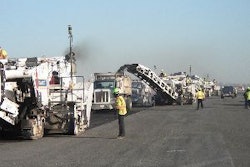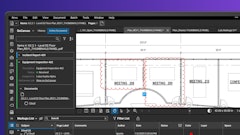
While working as an Owner's rep on a large construction project awhile back, the issue of scheduling became a hot lunch topic. The project was located just 90 minutes from the metro area. Just close enough for most of the field guys to commute. The question that we batted around frequently was "Why aren't they running 4 x 10's?"
We knew the simple explanation was "The GC will not allow it." We also know that the unanimous opinion among everyone else on site was "The GC is cutting off its nose to spite its face."
On a construction project like ours, running 4 x 10's should have been a no-brainer decision.
- It would have reduced travel reimbursements by 20% for several subs who were subsidizing their guys.
- It would have avoided a persistent labor shortage...and led to better qualified workers.
- It would have allowed the GC to avoid losing so much time to weather interruptions.
- It would have greatly increased productivity...again shortening the calendar.
- It would have generated much greater cooperation between the GC and its subs.
The field guys were asking about it all the time. Eventually, a couple of the big subs split their crews in half, working the first group Monday through Thursday and the second group Tuesday through Friday. Their crews were much more productive this way. It turned out to be a life saver as the project neared its conclusion.
These two subs didn't ask permission from the GC. Although the GC eventually became aware of the situation, the Project Manager and General Superintendent didn't make a public issue out of the disobedience of their rule. The situation evolved into a "Don't ask and don't tell" arrangement. This is further proof that it is often better to beg for forgiveness than to ask for permission.
Recently, one of my clients and I were discussing strategies for staffing his burgeoning workload when our discussion slid into the issue of 4 x 10's. The more we talked through the advantages and disadvantages and the ins and outs of making it work with the general contractors, it became apparent that most projects would benefit from running 4 x 10's.
The two most obvious benefits are the crews get more done and the schedule impact of rain is minimized.
Many contractors underestimate the impact of breaks. When you switch from 5 x 8's to 4 x 10's you remove two breaks from the forty hour work week. That's the obvious savings. The not so obvious savings is the stopping of work, taking the break, grabbing the tools and getting back after it.
During the transition into and out of breaks, worker productivity drops. For discussion purposes, let's assume those slowdowns are limited to 5 minutes before and 5 minutes after each break. Now you've saved 20 minutes in dead time and 20 minutes of slow time each week by switching to 4 x 10's.
The weather advantage is simple. If work rains out on Tuesday, the guys work Wednesday through Friday. The job stays on schedule and they get their 40 hours in. The key to this approach is communicating and over-communicating to the guys that they MUST leave their Friday's flexible. Supposedly, the same could be done on a 5 x 8 schedule but field crews typically are not open to giving up their Saturday's to keep the job on schedule. They would prefer the overtime be issued as a 5 x 10 schedule.
Field Worker Acceptance
I've rarely met a field worker that wouldn't opt for a 4 x 10 if given the chance. It cuts down on drive time. It frees up a day for whatever their hobby is, whether it be hunting and fishing, a side job they do for extra income, spending time with their wife and kids, or working on their house or care. They'll eagerly give up those two 10 minute breaks for the gain of a three day weekend.
General Contractor Resistance
Looping back to my project, our team couldn't figure out why the General Contractor was so resistant to the obvious benefits of 4 x 10's. If your crew finishes their 40 hours of work by Thursday evening, they are ahead of everyone else and it decongests the work space. There is less crawling around on top of each other which helps everyone's production.
Our GC stubbornly believed that every trade needed to be on site every day. That was pretty much total hogwash. The only trades who were significantly intertwined were the mason, the plumbers and the electricians. That situation would be easily solved by having a couple of electricians and a couple of plumbers assigned to hang with the mason crews. The rest of the 30 plumbers and 50 electricians were not going to be holding anyone up if they stayed home on Friday.
Most likely, you will need to pull your GC's project manager and superintendent aside and explain why you'd like to run 4 x 10's on their job, how it's going to benefit them, and why the entire project should be run 4 x 10.
You'll win a few and lose a few. Every time you sell the GC on the idea, your odds of bringing the job in under budget increase greatly.
The Exceptions
To start with, the 4 x 10 idea doesn't apply to trades who consistently work their crews 60 and 70 hours a week. A great example of this would be pavement maintenance contractors who work like mad men during the warm months and shut down their work during cold winters.
We would be remiss if we didn't mention the biggest reason not to go 4 x 10's. Doing heavy manual labor in extremely hot temperatures for 10 hours day after day will wear anyone out. When field workers wear out, they slow down, make mistakes, and are more prone to injury. So, there are times when shifting to 5 x 8's in July and August is the right thing to do.
Final Thoughts
One final advantage of working a project 4 x 10 is that you gain flexibility in moving staff around to help out when your work load exceeds your staff size. This was the problem my client and I were brainstorming about. How do we meet the work load, keep all the jobs on schedule, and avoid hiring a couple of short term field guys to handle the horrible schedule overlap? We knew the guys were most likely going to be working 48 to 50 hours a week, regardless. It just wasn't going to be on any one project as that pace would have messed up the sequencing with the other trades.
If you find yourself in a similar situation, at least consider going 4 x 10's on each project. It's a solution that often gets overlooked. It's a win - win whether you are swamped with work or not.
Should you have questions regarding 4 x 10s, or simply need help improving your field production, give us a call.




















